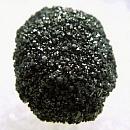|
|
||||||||||||||||
|
||||||||||||||||
|
||||||
|
|
|
|
Potosíite |
|
| | |
| Discovered in 1980; IMA status: Not Valid (IMA Approved 1981; IMA Discredited 1997) | ||
|
| ||
|
Chemistry |
|
|
| |
|
Pb6Sn24+Fe2+Sb25+S16 | |
|
|
Lead Tin Iron Antimony Sulfide |
|
Molecular Weight: |
2,228.89 gm |
|
Composition: |
Iron |
2.51 % |
Fe |
|
|
|
|
Tin |
10.65 % |
Sn |
|
|
|
|
Antimony |
10.92 % |
Sb |
|
|
|
|
Lead |
55.78 % |
Pb |
|
|
|
|
Sulfur |
20.14 % |
S |
|
|
|
|
|
100.00 % |
|
|
|
|
|
|
||||
|
Classification |
|
|
| |
|
Sulfides and Sulfosalts | |
|
2/C.17-50 | |
|
|
2 : SULFIDES and SULFOSALTS (sulfides, selenides,
tellurides; arsenides, antimonides, bismuthides; sulfarsenites,
sulfantimonites, sulfbismuthites, etc.) |
|
Related to: |
Franckeite Group. Sn(II)-poor variety of Franckeite. |
|
Members of Group: |
Franckeite Group: Coiraite, Franckeite |
|
Varieties: |
None |
|
Synonyms: |
IMA1980-057 |
|
|
|
|
Crystal Data |
|
|
|
|
|
As tabular crystals to 3 cm; may be in felted masses. |
|
|
Rare |
|
|
|
|
|
Physical Properties |
|
|
|
|
|
Perfect on || (001); less perfect on || (010) |
|
|
n/a |
|
|
Brittle |
|
|
2.5; Vickers: VHN100= 94 - 115 kg/mm2 |
|
|
6.20 (g/cm3) |
|
|
None |
|
|
Not Radioactive |
|
|
|
|
|
Optical Properties |
|
|
|
|
|
Bluish gray; grayish black; white in reflected light |
|
|
Opaque |
|
|
Metallic |
|
|
R1–R2: (400) 38.0–38.9, (420) 37.5–38.5, (440) 37.3–38.2, (460) 37.0–38.0, (480) 36.6–37.7, (500) 36.2–37.4, (520) 35.8–37.1, (540) 35.2–36.7, (560) 34.7–36.3, (580) 34.3–36.0, (600) 33.9–35.7, (620) 33.5–35.5, (640) 33.1–35.3, (660) 32.7–35.0, (680) 32.2–34.7, (700) 31.8–34.4 |
|
|
0.000 (Isotropic) |
|
|
n/a |
|
|
Faint; from bluish gray to yellowish gray |
|
|
Moderate; bluish gray to grayish pale yellow |
|
|
|
|
|
Occurances |
|
|
|
|
|
Geological Setting: |
On layered sulfide ore in a complex xenothermal-type hydrothermal tin deposit associated with subvolcanic granitic intrusive bodies (Andacaba deposit, Bolivia); in hydrothermal veins cutting rhyolite intrusions into highly kaolinized granite (Herb claim, Canada). |
|
Common Associations: |
Galena, Sphalerite, Semseyite, Cerussite, Cassiterite, Quartz (Andacaba deposit, Bolivia); Galena, Pyrite, Sphalerite, Arsenopyrite, Quartz (Herb claim, Canada); Arsenopyrite, Pyrrhotite, Stannite, Jamesonite, Pyrite, Sphalerite, Kutnahorite, Quartz (Hoei mine, Japan). |
|
Common Impurities: |
Ag, In |
|
Type Locality: |
Andacaba deposit, Linares Province, Potosí Department, Bolivia |
|
Year Discovered: |
1980 |
|
View mineral photos: | |
|
|
|
|
More Information |
|
|
|
|
|
| |
|
|
|
|
Distribution: the type locality [TL] at the
Andacaba deposit, Linares Province, Potosí Department, Bolivia.
At the San José Mine, Oruro City, Cercado Province, Oruro Department, Bolivia.
From the Herb claim, Turnagain River area, Cassiar district,
British Columbia, Canada. At the Oploca mine, Pirquitas
Ag-Sn Deposit, Rinconada Department, Jujuy, Argentina.
From the the Hoei tin mine, Bungo-Ohno City,
Oita Prefecture, Kyushu Region, Japan. |
|
|
We
have not photographed our Potosíite
gems yet. Please
check back soon. |
